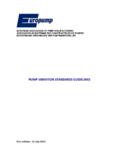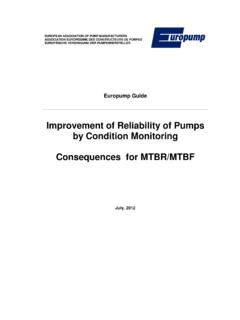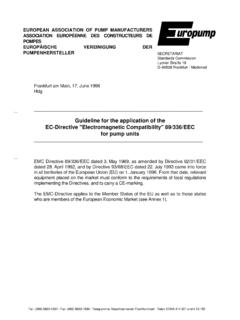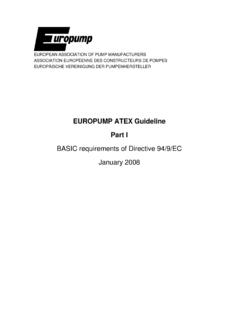Transcription of How the concepts of “House of Efficiency” and …
1 1 Ecopump work by europump Presented at the europump workshop Brussels, March 7, 2013 by Prof. Dr. Bernd Stoffel How the concepts of House of efficiency and Extended Product Approach were developed and what they meant for Ecodesign developments 2 Types of pump systems H Q Pump Process: circulation of liquid Need of the process: flow rate Q , pump head H Type: closed loop 3 3 Types of pump systems H Q Process: Transport of liquid to other location, higher elevation and/or higher pressure Pump Type: open loop Need of the process: flow rate Q pump head H 4 4 Electric power need of a pump system Need of the process: flow rate Q pump head H hydraulic power output Phyd ~ Q H pump efficiency pump mechanical pump power input Ppump ~ (Q H) / pump electric drive efficiency drive electric power input Pel ~ (Q H) / ( pump drive) 5 5 electric motor pump mech.
2 Coupling electric grid fluid discharge fluid inlet Q H Phydr pumps as Energy using Products (EuP s) 6 Need of the process: flow rate Q pump head H hydraulic power output Phyd ~ Q H pump efficiency pump mechanical pump power input Ppump ~ (Q H) / pump electric drive efficiency drive electric power input Pel ~ (Q H) / ( pump drive) measure of energy conversion quality of pump direct influence pumps as Energy using Products (EuP s) pump 7 7 Focus of europump work europump / Ecopump work already done and presently in progress focuses on pump types pump applications with highest contribution to energy consumption highest potential for energy saving 8 8 pumps and applications in the focus of work Examples of relevant applications: Commercial buildings, drinking water supply Heating, ventilation, air condition (HVAC) Water distribution, pressure boosting in high-rise buildings Irrigation Kinds of pumps presently*) in the focus: circulators water pumps *) but additional kinds of pumps (as waste water pumps ) already in the focus of new EC lots 9 Need of the process: flow rate Q pump head H hydraulic power output Phyd ~ Q H pump efficiency pump mechanical pump power input Ppump ~ (Q H) / pump electric drive efficiency drive electric power input Pel ~ (Q H) / ( pump drive) task: fulfillment of requirements of EU regulations aim: reduction of energy consumption and CO2 emission pumps as Energy using Products (EuP s) pump 10 10 Approach.
3 House of efficiency Background: in many processes, pumps are operated not only at (or very near to) their BEP, but in a range of Q/QBEP this applies to closed and open loops Consequence: energy efficiency of operation is determined not only by BEP, but also by pump efficiency at part load (Q < QBEP) and overload (Q > QBEP) assessment of pump quality regarding energy efficiency should be based on pump efficiency at 3 values of Q/QBEP so-called House of efficiency 11 11 Requirements on pump efficiency QPL QOL Q QBEP pump actual pump efficiency ( BEP) min,requ ( OL) min,requ ( PL) min,requ x x x covered range of requirements on pump: 75 110 % of QBEP house of efficieny 12 12 Minimum required pump efficiency Values of minimum required pump efficiency were elaborated by a study at TU Darmstadt are based on statistical evaluations of data of nearly state of the art pumps of European manufacturers, collected by questionnaires and on general fluiddynamic laws and technological aspects 13 Pump types included in the evaluation 14 )(22requmin,BEP x = ln(ns) y = ln(QBEP) Minimum required pump efficiency units: in % QBEP in m3/h HBEP in m nN, ns in 1/min i.
4 Number of stages depends on pump type nominal speed nN Minimum efficiency Index (MEI) Results of europump study carried out at Darmstadt University 15 Functional dependence of ( BEP)min,requ for a pump type a nominal speed a value of MEI Results of europump study carried out at Darmstadt University Minimum required pump efficiency QBEP ( BEP)min,requ 16 16 Minimum efficiency Index (MEI) MEI is a decimal number < serves for EU regulation on water pumps has a competitive effect on the market quantifies the cut-off effect 17 Table of C-values 18 18 Minimum required pump efficiency 020406080100120020406080100ns [min-1] [%]MEI = MEI = MEI = ns [min-1] ( BEP)min,requ MEI = MEI = MEI = Diagram valid for: pump type ESOB nN = 2900 1/min QBEP = 32 m3/h MEI = MEI = : 5 % corresponding Impeller shape: 19 19 type ESOB, nN = 2900 min-1 QBEP = 96 m3/h , HBEP = 25 m ns = 1/min MEI ( BEP)min,requ [%] Minimum required pump efficiency Example : 20 requmin,BEPrequmin, requmin,BEPrequmin, Minimum required efficiency at part load (Q = QBEP) Minimum required pump efficiency Further result fom statistical evaluation Minimum required efficiency at overload (Q = QBEP) 21 Statistical distribution of pump efficiency within a pump size resulting from manufacturing tolerances mean relative frequency of 95% probablilty interval of sx sx mean: mean value of sx.
5 Standard deviation of Tested pumps are samples of the corresponding size, uncertainty of mean decreases with increasing number of tested pumps 22 europump Joint Working Group EuP/ErP: Study on state-of-the-art Elaboration of draft standard CEN TC 197 EN 16480: pumps - Minimum required efficiency of rotodynamic water pumps 2nd version currently prepared for voting, publication expected still in 2013 European Commission Preparatory study on energy consumption and potential of energy saving Regulation 547/2012 Implementing Directive 2009/125/EC ..with regard to ecodesign requirements for water pumps (came into force 01/01/2013) Transitory document C 402/17 published 29/12/2012 (describes verification procedure, will be replaced by EN 16480) Legislation and standardisation on energy efficiency of water pumps 23 Full accordance exists in respect to scope definition and application of MEI as a measure for energy efficiency of pumps methodology to verify conformity by market surveillance Accordance of EU regulation 547/2012 and Standard EN 16480 24 Additional items of EU Regulation EU regulation 547/2012 sets minimum values of MEI to be fulfilled for conformity 1st step: MEImin = 2nd step.
6 MEImin = fixes dates for MEImin-values to become mandatory 1st step: 01/01/2013 2nd step: 01/01/2015 gives as a benchmark value MEI = describes product information requirements (nameplate, documents) 25 EN 16480 explains MEI and its background recommends and describes methods to qualify pump sizes for conformity with EU regulation (by the manufacturer) gives information on performing tests and evaluating test data in respect to MEI tolerances Additional items of EN Standard 26 Qualification of a pump size for MEI by the pump manufacturer Two possibilities provided in EU Regulation and in EN Standard Indication of conformity (EC sign) by proving that MEImean MEImin,requ Indication of MEImean as numerical value with 2 digits ( MEI )
7 27 Qualification of a pump size for MEI by the pump manufacturer Steps to do by the manufacturer: tests and evaluations on sample pumps as described in EN Standard the worst of the 3 -values (PL, BEP, OL) in respect to MEI of MEImean by linear interpolation between C-values given in the table and account of effects of measurement uncertainties and manufacturering tolerances on MEImean if MEImean fulfils requirement by law fulfillment or numerical value 28 Verification of MEI by market surveillance Procedureof verificationbymarketsurveillancecheck of documentationMEI confirmeddocumentationacceptable3 otherpumpsaretested& evaluatedaverageof 3 pumpspassesMEI rejectedtest pump passes1 pumpistested& evaluatedNONOYESYESYESNOP rocedureof verificationbymarketsurveillancecheck of documentationMEI confirmeddocumentationacceptable3 otherpumpsaretested& evaluatedaverageof 3 pumpspassesMEI rejectedtest pump passes1 pumpistested& 29 QBEP Verification of MEI by market surveillance Q.
8 Fitting curve from test threshold values for verification = (values calculated for relevant MEI) Q QPL QOL total tolerance on min,requ efficiency values calculated from equation min,requ = f(ns,QBEP, MEI) with MEI = MEIrequ t ,tot = 5% threshold values 30 30 Typical features of relevant applications For many applications in the focus at most part of operating time, the needed flow rate is < Q100% the head Hprocess needed by the process decreases with decreasing flow rate Q representative load profiles or duty profiles (= time fractions at Q/Q100%) can be defined also representative control curves Hprocess = f(Q) can be defined 31 Reference load (duty) profiles load profile closed loop01020304050255075100Q/Q100% [% ]time fraction [%]load profile open loop01020304050102030405060708090100Q/Q1 00% [% ]time fraction [%] 32 Reference control curves reference control curve and hydraulic load points,open loops0255075100020406080100Q/Q100%H/H100 %reference control curve and hydraulic load points,closed loops0255075100020406080100Q/Q100%H/H100 %reference control curves hydraulic load points 33 Extended product approach Energy efficiency of pump units (= pump + motor system) can be better assessed by the Energy efficiency Index (EEI) *) ref,elav g,elPPEEI Definition of EEI: Ni1ii,eltotav g,elPttPwith.
9 Extended Product Approach (EPA) *) EEI is already established in EN-Standardization and EU-Regulation for circulators 34 Extended product approach Definition of pump units as Extended Product (according to europump and CENELEC): A pump unit as an Extended Product (EP) consists of a pump driven by an electric motor system A motor system is an electric motor with or without a CDM (Complete Drive Module) A PDS is a motor system with a CDM (Complete Drive Module) for variable speed operation 35 08/03/2013 35 Example for Extended Product: Source: CENELEC PDS Standard, page 3 The Extended Product Approach needs additionally a duty profile and a control curve. Process System feed back* Basic Drive Module (BDM) Motor Starter ( contactor , softstarter.
10 Auxil - iaries Complete Drive Module (CDM) Power Drive System (PDS) Trans - mission Load Machine Driven equipment Mains & mains cabling Motor Control System = CDM orStarter Motor System Extended Product Feedin g section Auxil - iaries Motor Basic Drive Module (BDM) Motor Starter ( contactor , softstarter .. ) Auxil - iaries Complete Drive Module (CDM) Power Drive System (PDS) Trans - mission Load Machine Driven equipment Mains & mains cabling Motor Control System = CDM orStarter Motor System Extended Product Feeding section Auxil - iaries Motor 36 36 Extended Product Approach (EPA) Need of the process: flow rate Q pump head H hydraulic power Phyd ~ Q H pump efficiency pump mechanical pump power input Ppump ~ (Q H) / pump motor system efficiency drive electric power input Pel ~ (Q H) / ( pump drive) Pump unit = Extended Product aim: reduction of energy consumption and CO2 emission 37 37 Energy efficiency Index (EEI) Project of europump Joint Working Group EuP/ErP with TU Darmstadt on development and validatio




